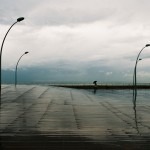As we await two expected tropical cyclones in North Queensland the following questions have a particular poignancy. What is the solution to coast inundation? Are there ways in which we can get used to getting wet and enjoy it as part of the experience – akin to playing in the surf?
While the Israeli port project may not offer the solution to the landfall of tropical cyclones, it might inspire ways to accommodate a slightly less defined and changeable boundary between the sea and land.
Mayslits Kassif Architects urban regeneration of the Tel Aviv Port is a landmark project which saw “the suspension of all the area’s rezoning plans” and set a precedent for “transformation not propelled by building rights, but by a unique urban design strategy.” The project received the 2010 Rosa Barba European Landscape Prize.



I think the analogy to ‘playing in the surf’ is exactly right. Coastal dwellers need to get used to getting wet – and they need to adapt their architecture and garden design ideas to protect those things which must be protected. Another aspect of Waffle Cities, is that their gardens should have platforms onto which cars can be driven when floods are predicted. Similarly, electricity supply cables should be routed on embankments or on posts on embankments.
Shops get a customer boost through flood tourism: [ http://www.flickr.com/photos/ismon/1963176567/ ]. Flood warning system, defended buildings, substation on stilts: [ http://www.flickr.com/photos/rontronic/1981789814/ ]. Flood architecture: [ http://www.flickr.com/photos/dhearjhohnny/2304722259/ ]. The low-tech solution: [ http://www.flickr.com/photos/dago_hh/2373045633/ ]. Rising water levels: [ http://www.flickr.com/photos/50512772@N07/4893467149/ ]. Got used to floods already: [ http://www.flickr.com/photos/jannesm-sp/5174675955/ ].
It seems there are many facets to designing what Deiseitl calls the ‘Hydropolis'[ http://www.stirlingcitycentre.com.au/assets/Uploads/INVOLVEfestival-water-and-public-realm1.pdf ] and these Dutch researchers have called ‘Water cities’
[ http://documents.irevues.inist.fr/bitstream/handle/2042/35639/13102-306VAN.pdf?sequence=1 ] and you have called ‘Waffle cities’.
It may be that rivers, creeks and canals could have several levels and types of embankment and opportunities for crossing?
[ http://www.flickr.com/photos/23781193@N05/2266003882 ]
And that buildings might be designed to stand in water? [ http://inhabitat.com/tower-city-is-an-ecotopia-stacked-upon-stilts/ ]
Thank you both for a fascinating set of links. My favourite is the link to the Water of Leith. I lived beside the river as a child and one of the family stories was of one of us waking up in the night, stepping out of bed and screaming at having put a foot into a full potty. In the morning we discovere that the river had flooded and the water had entered the house. There was a wall at the end of the garden which should have kept the water out but our neighbour had made a hole in the wall to let a duck waddle into her garden.
These links to photograhs are making me wonder if a Co-operation (ie ‘Competition’) for the design of Floodable & Waffle Cities should be more about photographs than about drawings. One could make a good case for ALL cities being designed to tolerate flood events of various severity and frequency. In the British Isles this would be a return to the time of the Crannog.
I’m all for mixing it up in terms of presentation, solutions with photographs, drawings, text etc maybe even models. I like the idea of both Floodable and Waffle Cities with many different kinds of structures, landscaping and responses to both keeping water out, letting water in, living on the water, living in the water and living above the water.
The Crannog reminds me of the bungalows at Irriki Resort in Vanuatu which sit over the tidal waters of the lagoon. [ http://commons.wikimedia.org/wiki/File:Iririki,_Vanuatu.jpg ]
The Netherlands National Water Plan deals with many of these issues. It is available in English http://english.verkeerenwaterstaat.nl/english/topics/water/water_and_the_future/national_water_plan/
I really like the prospect of an competition/co-operation to bring ideas together but am unsure about the best way of organizing it. The Flickr group we used for the Tiananmen Competition worked well but was more specific in its aims and was mostly to do with images. We obviously could not do anything as comprehensive as the Dutch National Water Plan, but we could perhaps do something more visual and more inventive. Ideas welcome!
Thank you. I think this statement from the Dutch Water Vision sums up what we are trying to achieve:
“There are no ready-made solutions. Determination and creativity will be necessary if we are to come up with the right solutions over the next few years. The quest for them will need to produce fundamental changes in the way we think and behave and in the application of innovative
concepts (transition). Such innovations will have to take account of the natural qualities of the water system itself while, at the same time, promoting economic development and enhancing environmental quality.”
Perhaps we could have a four cities ideas competition for waffle and floodable cities? The four cities could be cities familiar to the judges so that we gain the advantage of local knowledge in the establishing the competition and providing critiques. So Brisbane, Hamburg, London and Tianjin, all which experience flooding due to different factors and have different histories and preparatory strategies in place, seem the obvious choice.
I think the predominantly visual focus is appropriate with perhaps a design statement to say how the design responds to existing or informs future water policy.